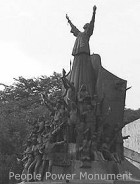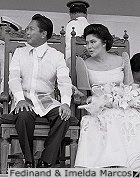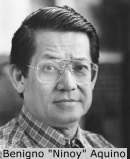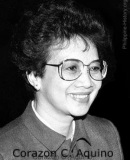|







| |
EDSA People Power Revolution
 The
Philippines was praised worldwide in 1986, when the so-called bloodless
revolution erupted, called EDSA People Power’s Revolution. February 25, 1986
marked a significant national event that has been engraved in the hearts and
minds of every Filipino. This part of Philippine history gives us a strong sense
of pride especially that other nations had attempted to emulate what we have
shown the world of the true power of democracy. The true empowerment of
democracy was exhibited in EDSA by its successful efforts to oust a tyrant by a
demonstration without tolerance for violence and bloodshed. Prayers and rosaries
strengthened by faith were the only weapons that the Filipinos used to recover
their freedom from President Ferdinand Marcos’s iron hands. The Epifanio de los Santos Avenue (EDSA)
stretches 54 kilometers, where the peaceful demonstration was held on that
fateful day. It was a day that gathered all Filipinos in unity with courage and
faith to prevail democracy in the country. It was the power of the people, who
assembled in EDSA, that restored the democratic Philippines, ending the
oppressive Marcos regime. Hence, it came to be known as the EDSA People Power’s
Revolution. The
Philippines was praised worldwide in 1986, when the so-called bloodless
revolution erupted, called EDSA People Power’s Revolution. February 25, 1986
marked a significant national event that has been engraved in the hearts and
minds of every Filipino. This part of Philippine history gives us a strong sense
of pride especially that other nations had attempted to emulate what we have
shown the world of the true power of democracy. The true empowerment of
democracy was exhibited in EDSA by its successful efforts to oust a tyrant by a
demonstration without tolerance for violence and bloodshed. Prayers and rosaries
strengthened by faith were the only weapons that the Filipinos used to recover
their freedom from President Ferdinand Marcos’s iron hands. The Epifanio de los Santos Avenue (EDSA)
stretches 54 kilometers, where the peaceful demonstration was held on that
fateful day. It was a day that gathered all Filipinos in unity with courage and
faith to prevail democracy in the country. It was the power of the people, who
assembled in EDSA, that restored the democratic Philippines, ending the
oppressive Marcos regime. Hence, it came to be known as the EDSA People Power’s
Revolution.
 The
revolution was a result of the long oppressed freedom and the life threatening abuses
executed by the Marcos government to cite several events like
human rights violation since the tyrannical
Martial Law Proclamation in 1972. The
revolution was a result of the long oppressed freedom and the life threatening abuses
executed by the Marcos government to cite several events like
human rights violation since the tyrannical
Martial Law Proclamation in 1972.
 In
the years that followed Martial Law started the suppressive and abusive
years–incidents of assassination were rampant, particularly those who opposed
the government, individuals and companies alike were subdued. The Filipinos
reached the height of their patience when former Senator Benigno
"Ninoy" Aquino, Sr. was shot and killed at the airport in August 21, 1983, upon his return to
the Philippines from exile in the United States. Aquino’s death marked the day
that Filipinos learned to fight. His grieving wife, Corazon
Cojuangco-Aquino showed the Filipinos and the world the strength and courage to claim back
the democracy that Ferdinand Marcos arrested for his personal caprice. Considering the
depressing economy of the country, Ninoy’s death further intensified the
contained resentment of the Filipinos. In the efforts to win back his popularity
among the people, Marcos held a snap presidential election in February 7, 1986,
where he was confronted with a strong and potent opposition, Corazon Aquino. It
was the most corrupt and deceitful election held in the Philippine history.
There was an evident trace of electoral fraud as the tally of votes were
declared with discrepancy between the official count by the COMELEC (Commission
on Elections) and the count of NAMFREL (National Movement for Free Elections).
Such blatant corruption in that election was the final straw of tolerance by
the Filipinos of the Marcos regime. In
the years that followed Martial Law started the suppressive and abusive
years–incidents of assassination were rampant, particularly those who opposed
the government, individuals and companies alike were subdued. The Filipinos
reached the height of their patience when former Senator Benigno
"Ninoy" Aquino, Sr. was shot and killed at the airport in August 21, 1983, upon his return to
the Philippines from exile in the United States. Aquino’s death marked the day
that Filipinos learned to fight. His grieving wife, Corazon
Cojuangco-Aquino showed the Filipinos and the world the strength and courage to claim back
the democracy that Ferdinand Marcos arrested for his personal caprice. Considering the
depressing economy of the country, Ninoy’s death further intensified the
contained resentment of the Filipinos. In the efforts to win back his popularity
among the people, Marcos held a snap presidential election in February 7, 1986,
where he was confronted with a strong and potent opposition, Corazon Aquino. It
was the most corrupt and deceitful election held in the Philippine history.
There was an evident trace of electoral fraud as the tally of votes were
declared with discrepancy between the official count by the COMELEC (Commission
on Elections) and the count of NAMFREL (National Movement for Free Elections).
Such blatant corruption in that election was the final straw of tolerance by
the Filipinos of the Marcos regime.
 The The
 demonstration
started to break in the cry for democracy and the demand to oust Marcos from his seat
at Malacañang Palace.
The revolt commenced when Marcos' Defense Minister Juan Ponce Enrile
and the Armed Forces Vice-Chief of Staff command of Fidel V. Ramos,
both withdrew their support from the government and called upon the resignation of then President Marcos.
They responsibly barricaded Camp Crame and Camp Aguinaldo and had their troops
ready to combat against possible armed attack organized by Marcos and his
troops. The Catholic Church represented by Archbishop Jaime Cardinal Sin along
with the priests and nuns called for the support of all Filipinos who believed in democracy.
Radyo Veritas aired the message of Cardinal Sin
that summoned thousands of Filipinos to march the street of EDSA. It was an empowering
demonstration that aimed to succeed peacefully with the intervention of faith.
Nuns kneeled in front of tanks with rosaries in their hands and uttering their
prayers. demonstration
started to break in the cry for democracy and the demand to oust Marcos from his seat
at Malacañang Palace.
The revolt commenced when Marcos' Defense Minister Juan Ponce Enrile
and the Armed Forces Vice-Chief of Staff command of Fidel V. Ramos,
both withdrew their support from the government and called upon the resignation of then President Marcos.
They responsibly barricaded Camp Crame and Camp Aguinaldo and had their troops
ready to combat against possible armed attack organized by Marcos and his
troops. The Catholic Church represented by Archbishop Jaime Cardinal Sin along
with the priests and nuns called for the support of all Filipinos who believed in democracy.
Radyo Veritas aired the message of Cardinal Sin
that summoned thousands of Filipinos to march the street of EDSA. It was an empowering
demonstration that aimed to succeed peacefully with the intervention of faith.
Nuns kneeled in front of tanks with rosaries in their hands and uttering their
prayers.
 With
the power of prayers, the armed marine troops under the command of Marcos
withdrew from the site. Celebrities expressed their support putting up a
presentation to showcase the injustices and the anomalies carried out by the
Marcos administration. Finally, in the morning of February 25, 1986, Corazon
Aquino took the presidential oath of office, administered by the Supreme Court
Associate Justice Claudio Teehankee at Club Filipino located in San Juan. Aquino
was proclaimed as the 11th President of the Republic of the Philippines.
She was the first lady president of the country. People rejoiced over their
victory proving the success of the EDSA People’s Power Revolution,
the historic peaceful demonstration. Although in 2001, there was an attempt to
revive People Power in the efforts to oust then President Joseph Estrada, it
was not as strong as the glorifying demonstration in 1986. The bloodless, People Power
Revolution in EDSA renewed the power of the people, strengthened the meaning of
democracy and restored the democratic institutions of government.
Continue to the 5th Republic (1986) up to the Present Time. With
the power of prayers, the armed marine troops under the command of Marcos
withdrew from the site. Celebrities expressed their support putting up a
presentation to showcase the injustices and the anomalies carried out by the
Marcos administration. Finally, in the morning of February 25, 1986, Corazon
Aquino took the presidential oath of office, administered by the Supreme Court
Associate Justice Claudio Teehankee at Club Filipino located in San Juan. Aquino
was proclaimed as the 11th President of the Republic of the Philippines.
She was the first lady president of the country. People rejoiced over their
victory proving the success of the EDSA People’s Power Revolution,
the historic peaceful demonstration. Although in 2001, there was an attempt to
revive People Power in the efforts to oust then President Joseph Estrada, it
was not as strong as the glorifying demonstration in 1986. The bloodless, People Power
Revolution in EDSA renewed the power of the people, strengthened the meaning of
democracy and restored the democratic institutions of government.
Continue to the 5th Republic (1986) up to the Present Time.
Back to Philippine History - Home Page
|